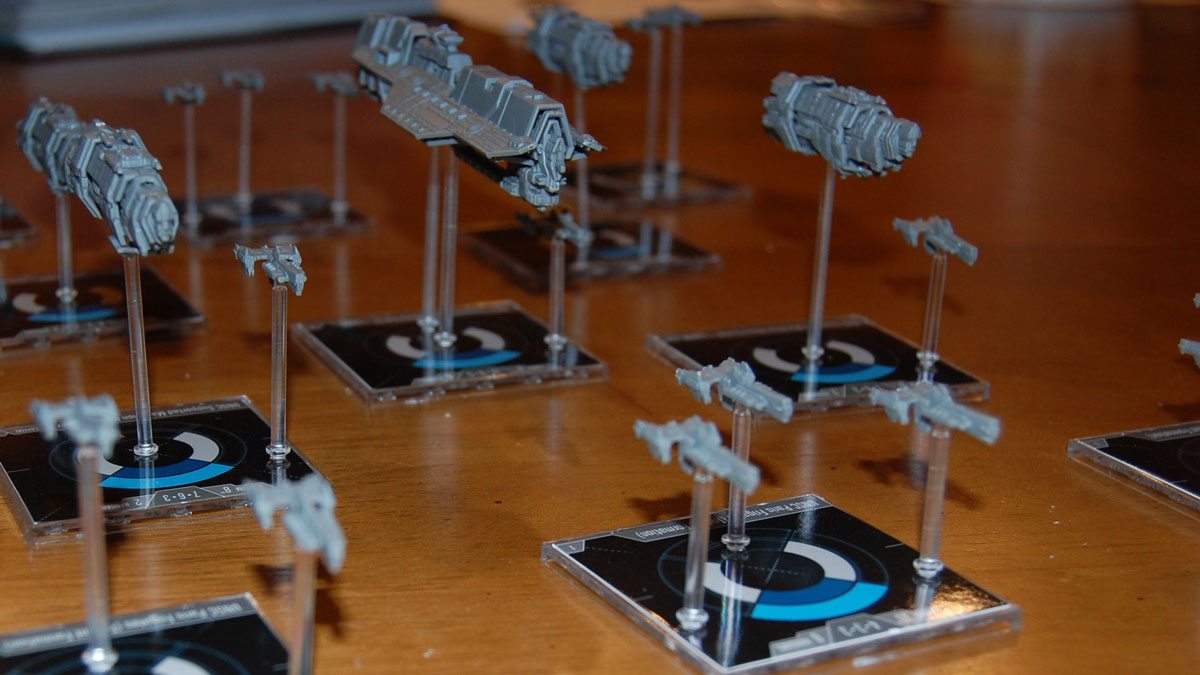
I should probably mention at the outset that I’m a big Halo fan. A couple of years ago, when we upgraded our home game console, we chose the Xbox 360 primarily because it allowed us to play all of the then-existing Halo games. We’re now discussing upgrading again, and it’s merely a matter of if, not what: our next console will also be an Xbox, because of Halo.
I’ve also been slowly building a collection of tabletop miniatures games. I have all three Star Wars titles: X-Wing Miniatures Battles, Imperial Assault, and most recently, Armada. I backed Sails of Glory and Shadows of Brimstone on Kickstarter, and got Wings of Glory for Christmas last year.
So I was obviously very excited when I first heard about Halo: Fleet Battles. Combining my all-time favorite video game with perhaps my favorite tabletop genre was a match made in heaven.
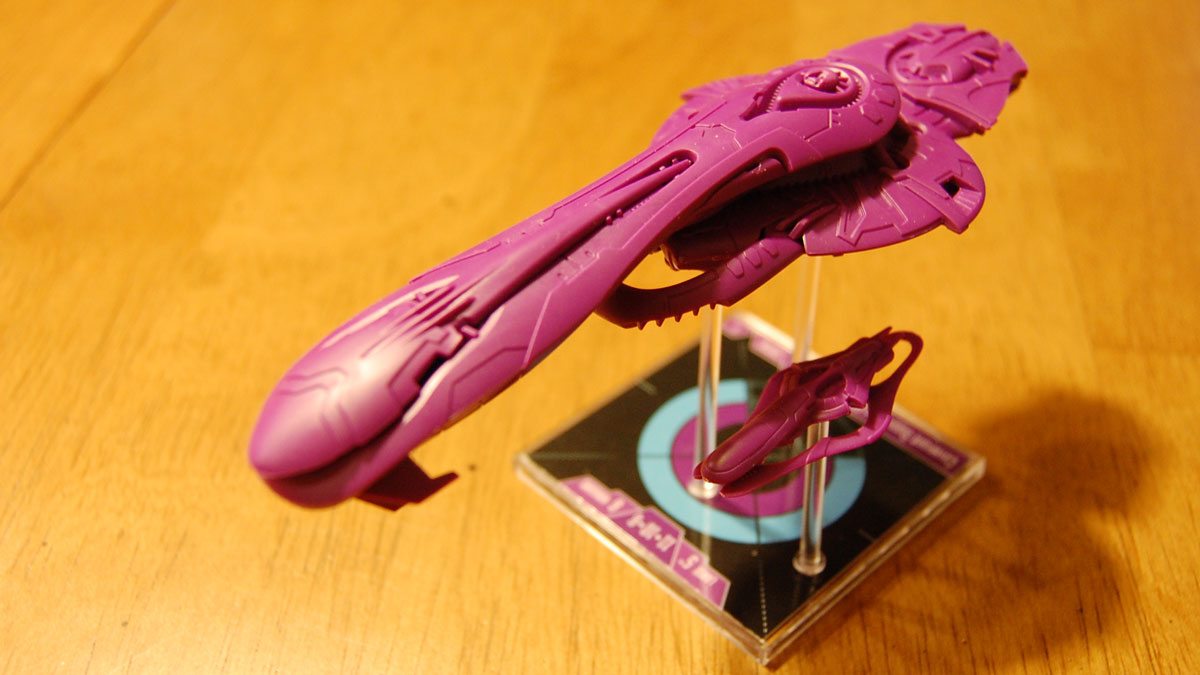
The first set, Fall of Reach, includes everything you need to get started playing in the Halo world on your tabletop. The game is designed for two players and is recommended for ages 12 and up (although there’s no way I’m keeping my nine-year-old Halo-obsessed son away from it.) Games usually run for an hour or two, depending on the scenario.
Disclaimer: I was given a copy of Halo:Fleet Battles for review.

Components:
- 49 plastic ship models: 1 UNSC (human) Epoch Heavy Carrier, 4 UNSC Marathon Heavy Cruisers, 27 UNSC Paris Frigates, 1 Covenant (alien) ORS Heavy Cruiser, 2 Covenant CCS Battlecruisers, 14 Covenant SDV Heavy Corvettes.
- 30 Custom Halo Dice
- Two Regular Six-sided Dice
- 128-page Core Rulebook
- Fall of Reach Campaign Guide
- 2 Fleet Commander Data Sheets
- 145 Flight Stands in Three Sizes
- 24 Ship Bases
- 30 Ship Overlay Sheets
- Punch-Out Scenery and Token Sheets
- One Model Assembly Guide
Set-up
Out of the box, the game takes quite some time to set up as the ship models do not come pre-assembled. I took me about 90 minutes to glue all of them together, and then another 45 minutes to remove the bases and stands from their runners and punch out all of the tokens, scenery and ship overlay tokens.
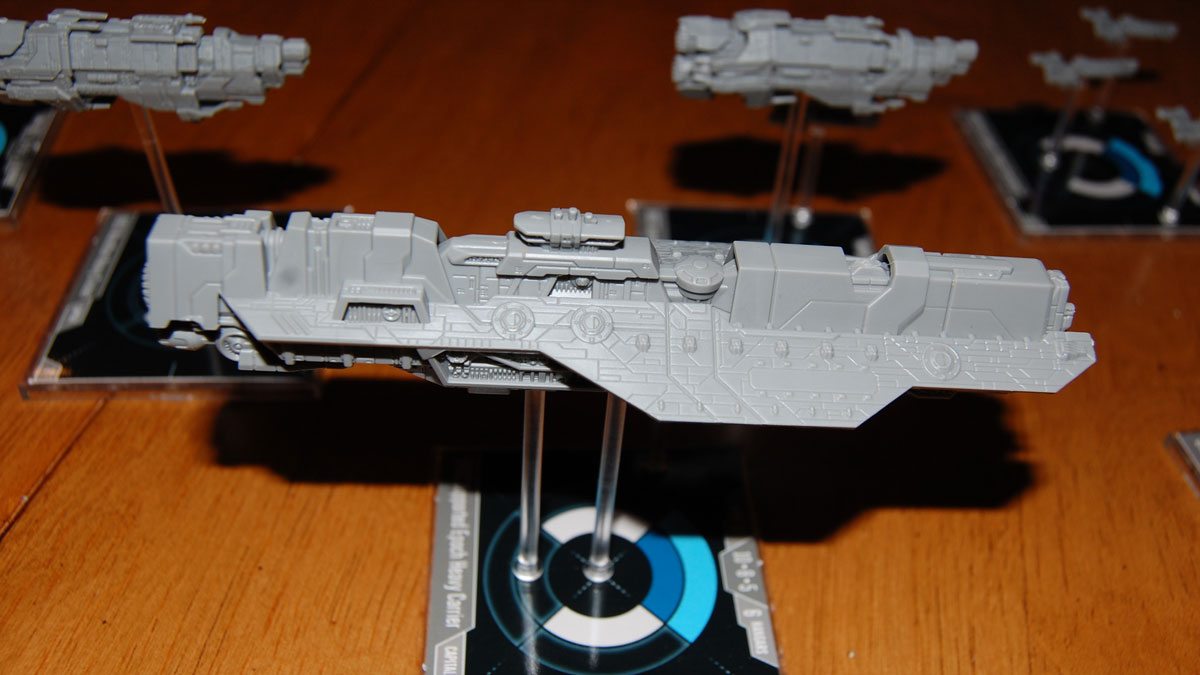
Once that part is done, setting up for each game isn’t too different from any other miniatures game. Each player builds a fleet by determining which ships they want to play with. This might eventually take a while as the company releases expansions, but the Fall of Reach set comes with just enough ships to perfectly outfit two fleets, so at least for now there are not a lot of decisions to be made on the fleet.
A more important decision is the formation of battle groups–sets of ships that will work together in combat. Forming the battle groups is the most important strategic decision to be made pre-game, but the core rulebook includes a suggested battle group setup that players can use for their first few games.

The models then need to be snapped into their bases. This is where one of the more innovative components of the game becomes apparent. The ship bases are a 5×5 grid of holes, allowing for a wide variety of ship configurations on a single stand. Bigger models such as the UNSC Heavy Carrier and the Covenant Heavy Cruiser are held securely by two pegs, removing the instability found on bigger models in some other systems. Smaller ships can be put two or three to a stand, in several different formations that impact game play.
Players then choose a scenario to play, find a nice big table (the recommended minimum playing area is 4’x4′), set up their battle groups along the edges of the table, take turns laying terrain (planets, asteroids, and the like) in each other’s way, and then begin the battle.
Game Overview
I’ll admit that at first glance, the game was pretty daunting with that 128 page rulebook. While it’s definitely necessary to read through it before the first play, the system turns out to be well designed and the game is easier to play than it first appears.

To begin, each player rolls a set of Order Dice–custom dice for each faction. They place these on their Commander Data sheets (the rules imply that more commanders will become available in future expansions, but for now there’s just one for each faction). Then, they determine initiative. The player with initiative then decides which player will go first.
Next, players execute the Wing phase. While Halo: Fleet Battles is primarily concerned with capital ship combat, it does acknowledge the existence of smaller fighters, bombers and landing craft by way to cardboard tokens. These are automatically created with the various battle groups and deployed on setup. The first player selects some fighters or bombers and moves them forward. As with many similar games, it takes a few turns for these to get into range, so at least on the first turn they’ll just move.
Movement in this game is much simpler than in the other ship-based miniature games I’ve played. You use a simple tape measure (that you supply), and each ship has a pre-set range of movement. Depending on the size of the ship, you can turn it up to 45 degrees either before the move, after, or both.
Once all of the small craft have moved, the big ships take their turn. Again using the turn order, each player selects a single battle group and moves all of its ships. Once they move, they can attack if they’re in range.
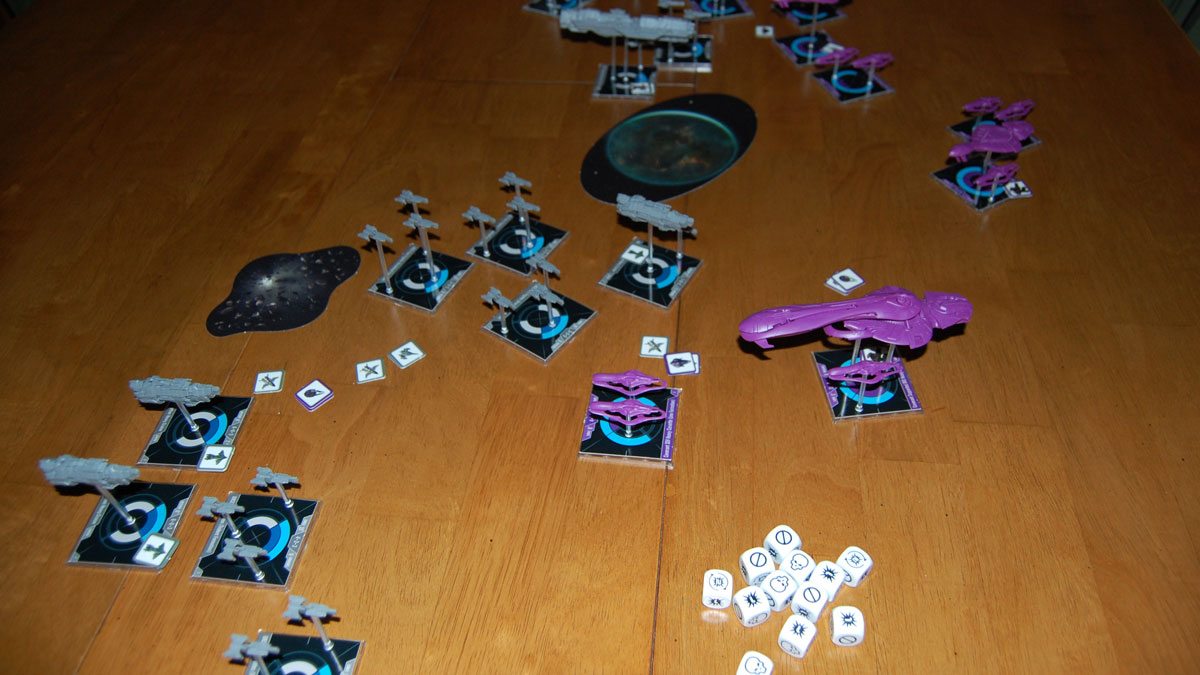
Combat is likewise surprisingly straight-forward. The player adds up the combat value of all of the weapons in the battle group, which are printed on a set of included reference sheets, and rolls that number of Halo dice. The dice have either a single success icon, a double success icon, a miss icon or a fail icon. Some elements of the game allow for the die that came up on the miss icon to be re-rolled a single time, so if necessary the player re-rolls those. Then, the player simply adds up the number of successes.
The defending player then rolls a number of die as indicated on the reference sheet for the ship being targeted. The successes rolled here cancel out an equal number of successes from the attacker. The end total of attacking successes then hit the ship.
This is the point where a lot of similar games get bogged down in paperwork or checking things on tables and the like, but Halo: Fleet Battles does none of this with a brilliantly simple mechanic that’s easy to implement and keeps the game moving. Each ship has three damage numbers, printed on the ship overlay and on the reference sheet. If the total number of attacking success rolls equals or exceeds the first of these numbers, the ship is damaged and gets a damage token. From then on, damage is compared to the second number, until an attack succeeds again, at which time it gets a second token. Once the third number is exceeded, the ship is destroyed.

This battle group phase is repeated by each player in turn until all groups have moved. After that, the final combat phase begins. This again harkens back to the video game; in fact, the very opening of the first game. Each ship now has the ability to launch boarding parties, which will fly to enemy ships and attempt to damage or destroy them. This phase is ultimately handled as elegantly as ship-to-ship combat.
Finally, once all of the boarding parties have done their thing, there’s a fairly quick end phase, where players can attempt to repair damage and carriers can launch new waves of bombers and fighters. After that, the whole thing starts again until one side gains a pre-determined number of victory points or a set number of turns have elapsed.
The Verdict
As I said above, the game turns out to be a lot simpler than it first appears. It was also an enormous amount of fun to play. It requires significantly less record keeping than similar games, which makes it a lot easier to learn and a lot more fun. It also doesn’t have tons of cards or other minutia that modify what’s going on but that is very easy to forget or get confused by.
The models are very nice and highly detailed. They come unpainted, but the company has smart enough to color-code them, with the UNSC forces in grey and the Covenant in purple, making the game entirely playable out-of-the-box. While I do plan to eventually paint mine, it’s nice that the game can be played without absolutely needing to paint.
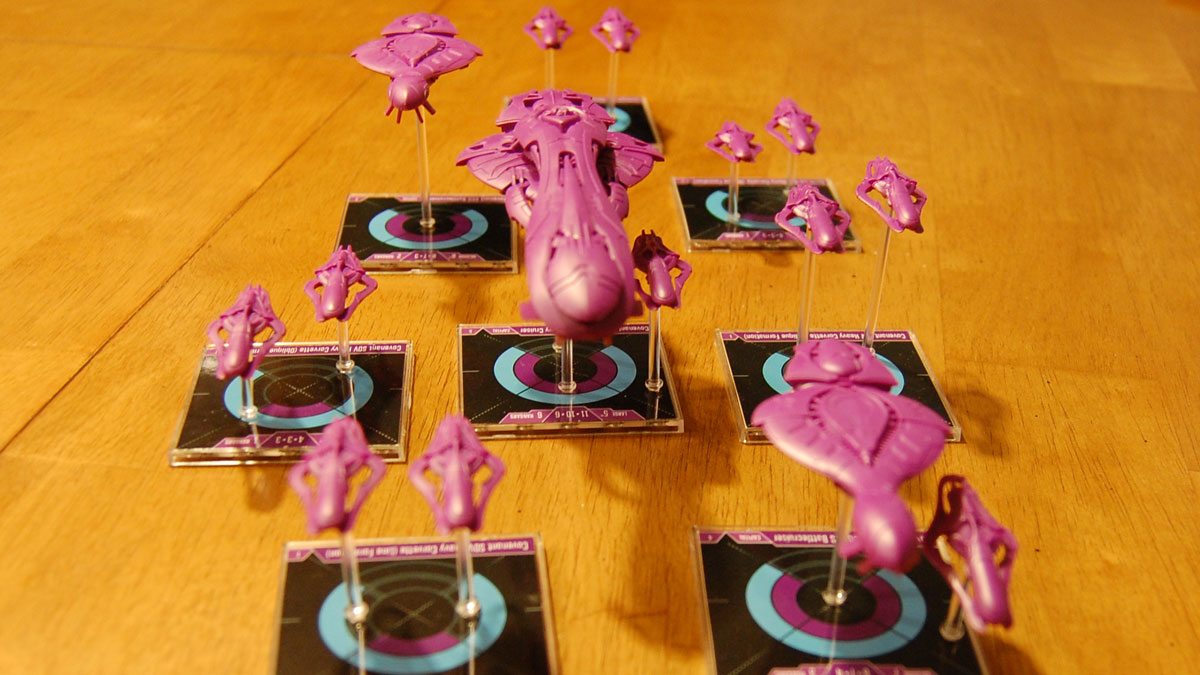
The rules make references and even include pictures of ships not included in the set, so it’s not only clear that they plan to make expansions, but also that the first expansions may be very close to being released. I for one can’t wait to see where they take the game moving forward, but they’re certainly off to a great start.
While Halo: Fleet Battles isn’t cheap–it retails for $129–it’s a great game and well worth the cost, both for fans of Halo and for fans of miniatures combat games.


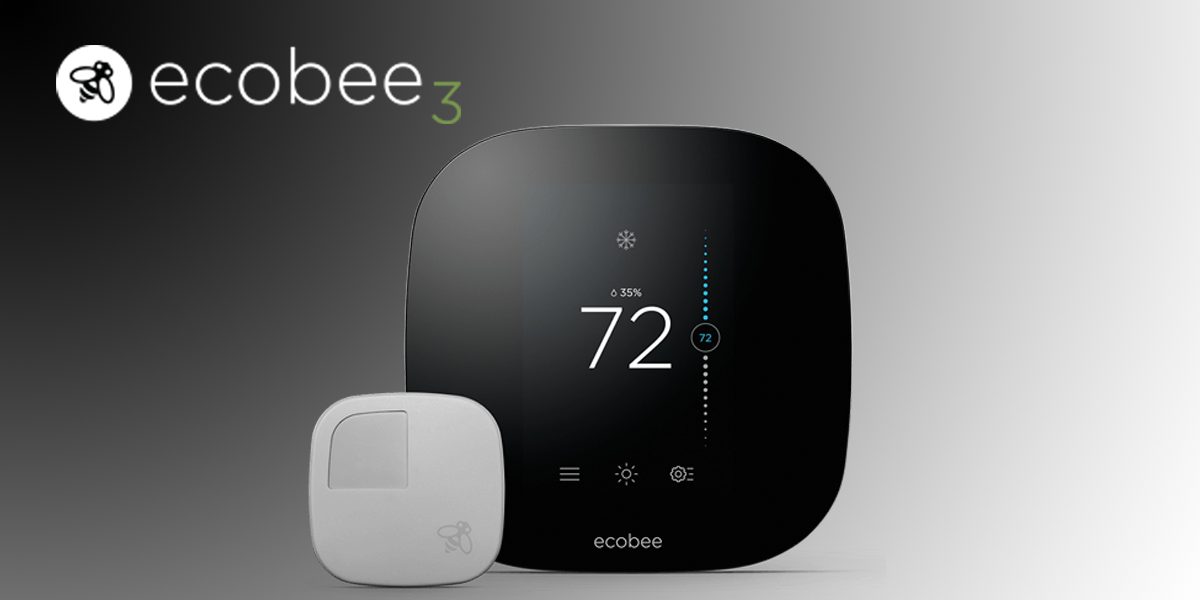
I just got this, and it seems very difficult to put the pegs in/take them out from the base. Did you have similar problems, and have advice? Right now it seems like the formations are basically stuck, because I broke one peg trying to pull it out of the stand and cracked the base trying to take out another. So yeah, any advice with the pegs and base would be appreciated.
Thank you!
had same problem with star trek version attack wing
stands are terrible